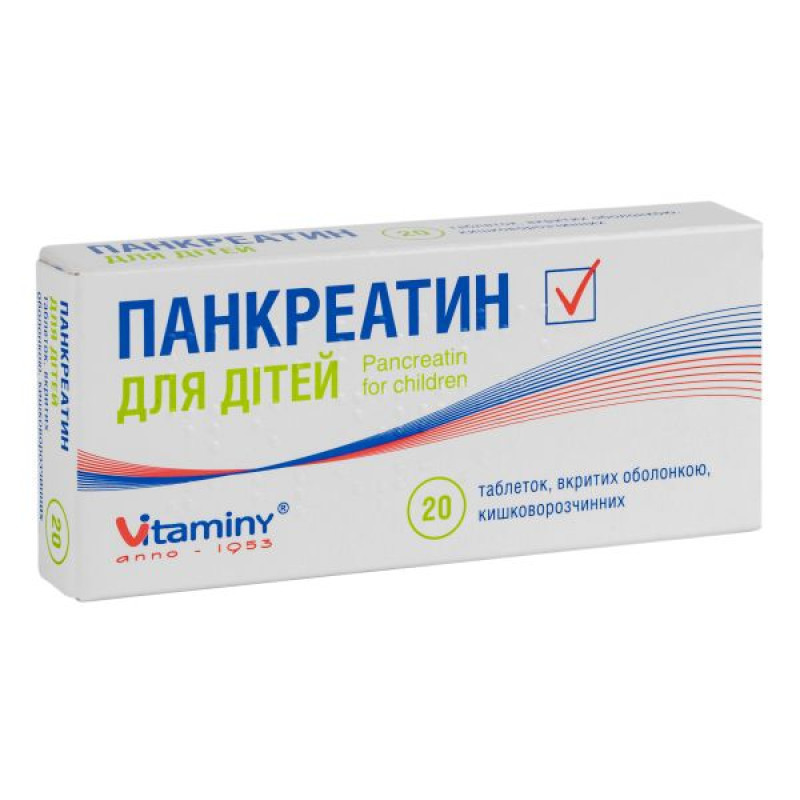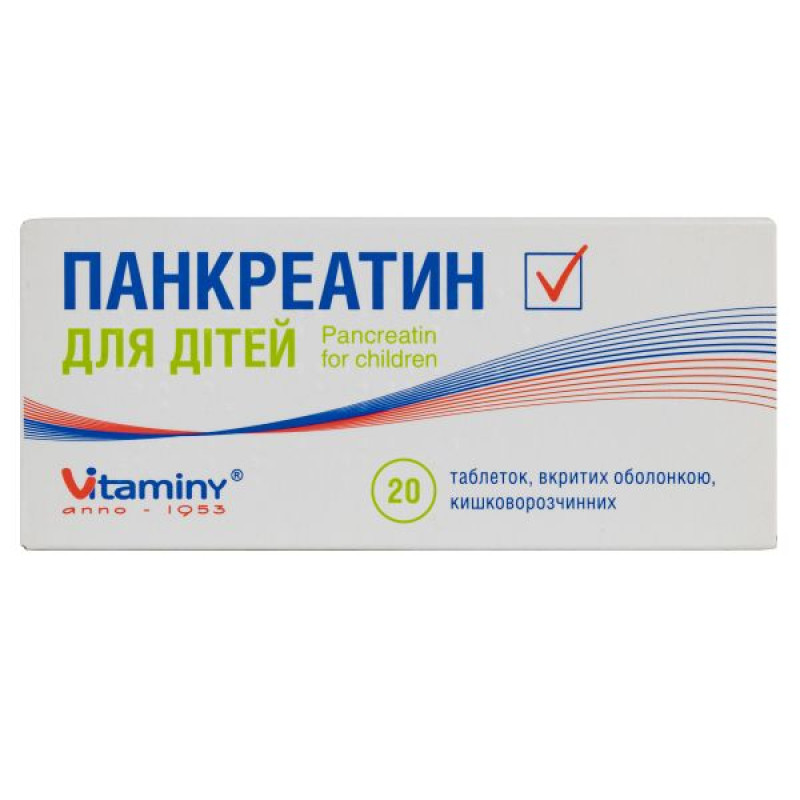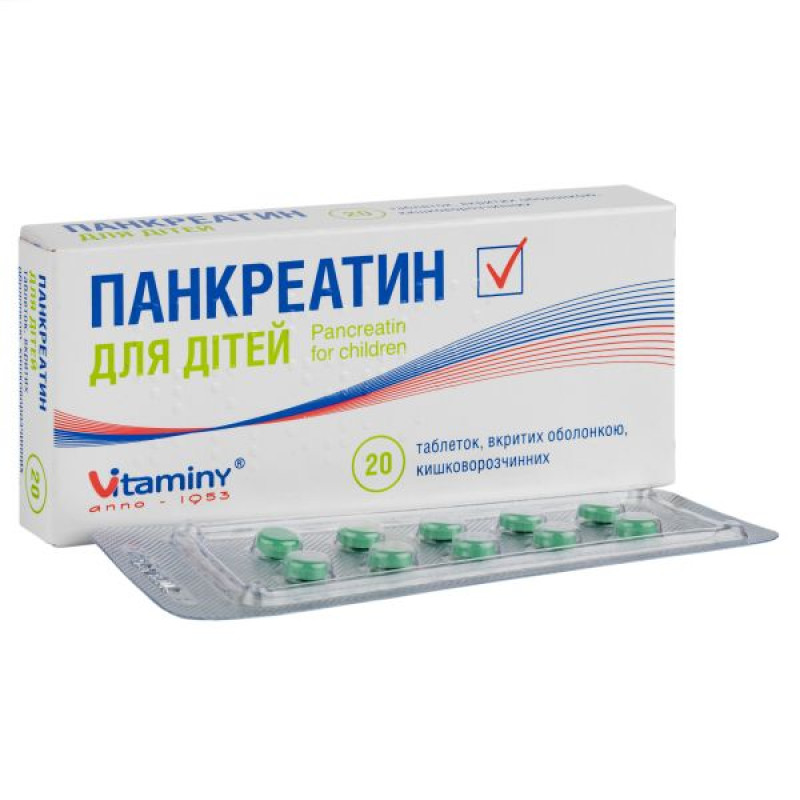Pancreatin for children enteric-coated tablets blister No. 20

Translation of the instructions can be
PANCREATIN FOR CHILDREN enteric-coated tabletsInstruction
For medical use of the medicinal product
Pancreatin for children
Composition:
Active ingredient: pancreatin;
1 tablet contains pancreatin, which corresponds to the minimum enzymatic activity: 750 amylolytic U Ph. Eur. 1000 lipolytic U Ph. Eur., 75 proteolytic U Ph. Eur.;
excipients: lactose, monohydrate; povidone; calcium stearate; acrylic green 93O31213 [mixture of dry substances: methacrylate copolymer (type C), talc, titanium dioxide (E 171), triethyl citrate, iron oxide yellow (E 172), silicon dioxide colloidal anhydrous, sodium bicarbonate, sodium lauryl sulfate, diamond blue (E 133)].
Dosage form.
The film-coated tablets are enteric-coated.
Main physicochemical properties: round tablets, coated, with a smooth, biconvex surface, from light green to green in color, the presence of a specific odor is allowed. When viewed under a magnifying glass, a core surrounded by one continuous layer is visible on the fracture.
Pharmacotherapeutic group.
Digestive aids, including enzymes. Polyenzyme preparations.
PBX code A09A A02.
Pharmacological properties.
Pharmacodynamics.
Pancreatin contains excretory enzymes of the pancreas of pigs and cattle: lipase, amylase, trypsin and chymotrypsin - which are involved in the digestion of fats, carbohydrates and proteins, contributing to their more complete absorption in the small intestine. When using pancreatin, the digestion process is normalized, the functional state of the intestine is improved.
Pharmacokinetics.
Due to the acid-resistant coating, the enzymes are inactivated by the hydrochloric acid of the stomach. The dissolution of the shell and the release of enzymes begins in the duodenum. The enzymes are poorly absorbed in the digestive tract, act in the intestinal lumen, and are excreted in the feces.
Clinical characteristics.
Indication.
dyspepsia; simultaneous consumption of indigestible vegetable, fatty or unusual food; flatulence associated with the above disorders; acceleration of the passage of food in the intestines of a functional nature.
Contraindication.
Individual hypersensitivity to pancreatic enzymes of animal origin or to any of the components of the drug. acute pancreatitis, chronic pancreatitis in the acute stage. obstructive intestinal obstruction.
Interaction with other drugs and other types of interactions.
With simultaneous use of pancreatin with antithrombotic agents, vitamin D antagonists and acetylsalicylic acid, the effect of these drugs is reduced. The effectiveness of non-selective monoamine reuptake inhibitors is also reduced when used together with pancreatin.
When used simultaneously with M-cholinoblockers, the anticholinergic effect is enhanced.
When using pancreatin, the absorption of iron and folic acid may be reduced. Simultaneous use of antacids containing calcium carbonate and/or magnesium hydroxide, with tannin, alcohol-containing products may lead to a decrease in the effectiveness of pancreatin.
Application features.
Digestive system disorders may occur in patients with hypersensitivity to pancreatin or in patients with a history of meconium ileus or intestinal resection.
It should be noted that the presence of a methacrylic acid derivative in the composition of the medicinal product may lead to the risk of developing fibrosing colonopathy when using high doses. If signs of colonic obstruction occur during the use of the drug, the patient should be examined for the presence of fibrosing colonopathy as a possible cause of this pathological condition.
To avoid the formation of uric acid stones, the uric acid content in the urine should be controlled.
The medicine contains active enzymes that can damage the oral mucosa, so the tablets should be swallowed whole, without chewing.
When taking the drug before meals, it should be washed down with alkaline liquids (for example, Borjomi mineral water or 0.5-1% sodium bicarbonate solution).
With prolonged use, simultaneous administration of iron preparations is recommended.
The drug contains lactose, therefore, if the patient has been diagnosed with intolerance to some sugars, you should consult a doctor before taking this drug.
Use during pregnancy or breastfeeding.
The drug should not be used in patients of reproductive age.
The ability to influence the reaction speed when driving vehicles or other mechanisms.
There are no reservations.
Method of administration and doses.
Tablets should be taken before or during each meal, without chewing, with plenty of liquid. The dose of the drug is set individually by the doctor, depending on the age and degree of enzyme deficiency, and may be changed.
For children aged 3-5 years, a single dose is 1 tablet; 6-7 years - 1-2 tablets; 8-9 years - 2 tablets; 10-14 years - 2-4 tablets.
The duration of treatment is determined by the doctor individually.
Children.
The drug should be used in children aged 3 to 14 years (see the "Method of administration" section).
Overdose.
Hyperuricemia and hyperuricosuria have been observed when extremely high doses of the drug were administered. Fibrosing colonopathy may develop when high doses of the drug are administered.
Treatment: drug withdrawal, symptomatic therapy.
Adverse reactions.
On the part of the digestive system: diarrhea, constipation, flatulence, discomfort in the stomach, abdominal pain, nausea, vomiting, change in the nature of stools, the appearance of strictures of the colon or ileocecal part of the intestine. In case of unusual abdominal symptoms or increased pain, it is necessary to exclude the possibility of developing fibrosing colonopathy.
On the part of the immune system: allergic reactions, including skin itching, skin rash, runny nose, sneezing, lacrimation, bronchospasm, urticaria, anaphylactic reactions, angioedema.
Metabolic: when using the drug in high doses in children, perianal skin irritation may occur.
Expiration date.
2 years.
Storage conditions.
In the original packaging at a temperature not exceeding 25 ºС.
Keep out of reach of children.
Packaging.
10 tablets in a blister, No. 10 × 2 or No. 10 × 6 blisters in a pack.
Vacation category.
Without a prescription.
Producer.
Pao "vitamins".
Location of production and its address of location of activity.
20300, Ukraine, Cherkasy region, M uman, Leninsky Iskra St., 31.
Applicant.
Pao "vitamins".
Location of the applicant.
20300, Ukraine, Cherkasy region, M uman, Leninsky Iskra St., 31.
There are no reviews for this product.
There are no reviews for this product, be the first to leave your review.
No questions about this product, be the first and ask your question.











